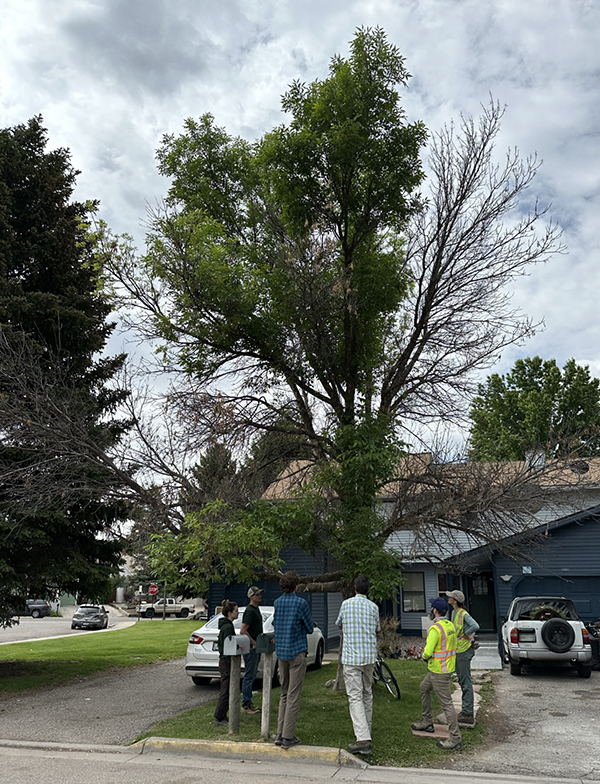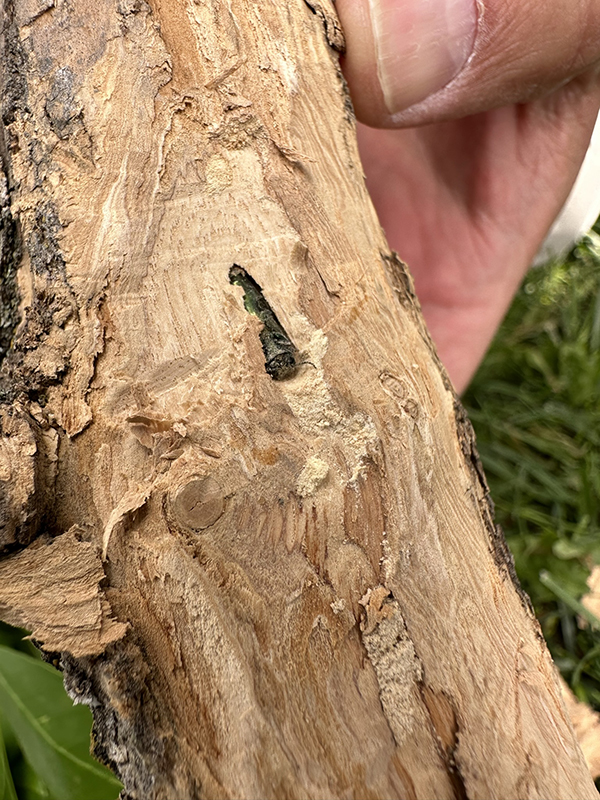
FORT COLLINS, Colo. – In June 2023, experts from Colorado State University confirmed the presence of emerald ash borer (EAB) in two new towns in Colorado: Carbondale and Littleton. EAB has been present on Colorado’s Front Range since 2013, and the detection in the Town of Carbondale marks the first time EAB was confirmed in western Colorado.
“This is a large jump by the emerald ash borer to be found on the Western Slope; most likely it was brought into the community in firewood. This is just another example of why it’s so important to buy your firewood locally,” said Kamie Long, interim manager of Urban & Community Forestry at the Colorado State Forest Service. “The communities in the Roaring Fork Valley have been on the lookout for this insect for years, and Carbondale did a great job of identifying suspect trees and reaching out to the CSFS for assistance in confirming the insect’s identity.”
With ash trees estimated to comprise 15 percent or more of all urban trees in Colorado, this non-native, invasive pest poses a serious threat to urban forests. EAB attacks and kills both stressed and healthy ash trees, and it is so aggressive that trees typically die within two to four years after becoming infested.
EAB on the move
EAB was first confirmed in Colorado in 2013 in the City of Boulder. Since then, EAB has spread to other cities and towns on the Front Range and now west of the Continental Divide in Colorado.
“This confirmation marks a change in these communities in how they treat and manage their ash trees, and it will take an investment by the community to put resources into identifying, treating and/or replacing ash trees,” Long said.
Carbondale’s tree inventory includes approximately 470 ash trees on public property with even more ash trees on private property in this town about 30 miles northwest of Aspen, Colo.
“EAB is tough because it has probably been in town for two or more years, but I am just now noticing the obvious signs as trees are starting to decline,” said Carbondale’s Town Arborist Carl Meinecke.
Nearly 200 miles from Carbondale, Arapahoe County confirmed its first case of EAB in June 2023. While nearby cities of Broomfield, Erie and Thornton had already discovered the destructive beetle, this is the first confirmation in Littleton, Colo.

EAB Tips for Colorado Residents
- Determine now if you have any ash trees. Identifying features of ash trees include compound leaves with 5 to 9 leaflets; leaflets, buds and branches growing directly opposite from one another; and diamond-shaped bark ridges on mature trees. Check out more information about ash tree identification.
- If you have an ash tree, start planning. Decide if the overall health of the tree and the benefits it provides merit current or future treatment, or if it would be best to remove and replace it with a different species. If you are not sure, contact your local CSU Extension horticulture agent or an ISA Certified Arborist. If you do plan to treat the tree, the CSFS offers recommendations for selecting a tree care company.
- Plant trees. Replace ash trees in poor health with diverse species. The Colorado Department of Agriculture offers a database of registered nurseries and landscape contractors.
- Recognize signs of EAB infestation. Property owners with ash trees should be on the lookout for thinning of leaves in the upper tree canopy, 1/8-inch D-shaped holes on the bark and vertical bark splitting with winding S-shaped tunnels underneath.
- Help prevent further spread of EAB. Do not transport ash or any hardwood firewood, or any other untreated ash wood products. Dispose of ash wood safely by chipping, composting, milling into lumber or taking to a landfill.
Learn more about ash tree identification, the symptoms of EAB, treatment options and how to use ash wood.
“Tree diversity across the landscape is important and this is an opportunity for everyone to increase diversity and improve the health of the current and future forest.
Kamie Long, Interim Manager Urban & Community Forestry
About Emerald Ash Borer
Emerald ash borer (EAB) is a non-native, wood-boring beetle that is responsible for the death or decline of tens of millions of ash trees in the United States and Canada. This insect was first discovered in Michigan in 2002, and since then it has spread to at least 35 states, including Colorado. As a non-native insect, EAB lacks predators to keep it in check. EAB only attacks ash trees in the genus Fraxinus, but it has also been documented infesting white fringe tree. Mountain ash and other tree species are not susceptible.

